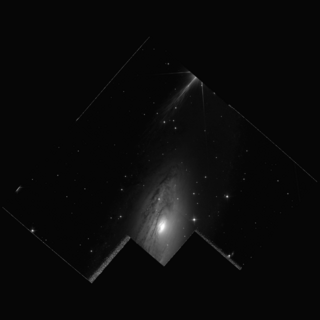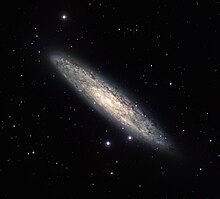
The Hubble sequence is a morphological classification scheme for galaxies published by Edwin Hubble in 1926. It is often colloquially known as the Hubble tuning-fork diagram because the shape in which it is traditionally represented resembles a tuning fork. It was invented by John Henry Reynolds and Sir James Jeans.

The rotation curve of a disc galaxy is a plot of the orbital speeds of visible stars or gas in that galaxy versus their radial distance from that galaxy's centre. It is typically rendered graphically as a plot, and the data observed from each side of a spiral galaxy are generally asymmetric, so that data from each side are averaged to create the curve. A significant discrepancy exists between the experimental curves observed, and a curve derived by applying gravity theory to the matter observed in a galaxy. Theories involving dark matter are the main postulated solutions to account for the variance.

An elliptical galaxy is a type of galaxy with an approximately ellipsoidal shape and a smooth, nearly featureless image. They are one of the four main classes of galaxy described by Edwin Hubble in his Hubble sequence and 1936 work The Realm of the Nebulae, along with spiral and lenticular galaxies. Elliptical (E) galaxies are, together with lenticular galaxies (S0) with their large-scale disks, and ES galaxies with their intermediate scale disks, a subset of the "early-type" galaxy population.

Spiral galaxies form a class of galaxy originally described by Edwin Hubble in his 1936 work The Realm of the Nebulae and, as such, form part of the Hubble sequence. Most spiral galaxies consist of a flat, rotating disk containing stars, gas and dust, and a central concentration of stars known as the bulge. These are often surrounded by a much fainter halo of stars, many of which reside in globular clusters.

A lenticular galaxy is a type of galaxy intermediate between an elliptical and a spiral galaxy in galaxy morphological classification schemes. It contains a large-scale disc but does not have large-scale spiral arms. Lenticular galaxies are disc galaxies that have used up or lost most of their interstellar matter and therefore have very little ongoing star formation. They may, however, retain significant dust in their disks. As a result, they consist mainly of aging stars. Despite the morphological differences, lenticular and elliptical galaxies share common properties like spectral features and scaling relations. Both can be considered early-type galaxies that are passively evolving, at least in the local part of the Universe. Connecting the E galaxies with the S0 galaxies are the ES galaxies with intermediate-scale discs.

In astronomy, a galactic bulge is a tightly packed group of stars within a larger star formation. The term almost exclusively refers to the central group of stars found in most spiral galaxies. Bulges were historically thought to be elliptical galaxies that happened to have a disk of stars around them, but high-resolution images using the Hubble Space Telescope have revealed that many bulges lie at the heart of a spiral galaxy. It is now thought that there are at least two types of bulges: bulges that are like ellipticals and bulges that are like spiral galaxies.

A ring galaxy is a galaxy with a circle-like appearance. Hoag's Object, discovered by Art Hoag in 1950, is an example of a ring galaxy. The ring contains many massive, relatively young blue stars, which are extremely bright. The central region contains relatively little luminous matter. Some astronomers believe that ring galaxies are formed when a smaller galaxy passes through the center of a larger galaxy. Because most of a galaxy consists of empty space, this "collision" rarely results in any actual collisions between stars. However, the gravitational disruptions caused by such an event could cause a wave of star formation to move through the larger galaxy. Other astronomers think that rings are formed around some galaxies when external accretion takes place. Star formation would then take place in the accreted material because of the shocks and compressions of the accreted material.

Galaxy morphological classification is a system used by astronomers to divide galaxies into groups based on their visual appearance. There are several schemes in use by which galaxies can be classified according to their morphologies, the most famous being the Hubble sequence, devised by Edwin Hubble and later expanded by Gérard de Vaucouleurs and Allan Sandage. However, galaxy classification and morphology are now largely done using computational methods and physical morphology.
The terms galactic corona and gaseous corona have been used in the first decade of the 21st century to describe a hot, ionised, gaseous component in the galactic halo of the Milky Way. A similar body of very hot and tenuous gas in the halo of any spiral galaxy may also be described by these terms.

A galactic disc is a component of disc galaxies, such as spiral galaxies, lenticular galaxies, and the Milky Way. Galactic discs consist of a stellar component and a gaseous component. The stellar population of galactic discs tend to exhibit very little random motion with most of its stars undergoing nearly circular orbits about the galactic center. Discs can be fairly thin because the disc material's motion lies predominantly on the plane of the disc. The Milky Way's disc, for example, is approximately 1 kly thick, but thickness can vary for discs in other galaxies.

The Milky Way is the galaxy that includes the Solar System, with the name describing the galaxy's appearance from Earth: a hazy band of light seen in the night sky formed from stars that cannot be individually distinguished by the naked eye. The term Milky Way is a translation of the Latin via lactea, from the Greek γαλακτικὸς κύκλος, meaning "milky circle". From Earth, the Milky Way appears as a band because its disk-shaped structure is viewed from within. Galileo Galilei first resolved the band of light into individual stars with his telescope in 1610. Until the early 1920s, most astronomers thought that the Milky Way contained all the stars in the Universe. Following the 1920 Great Debate between the astronomers Harlow Shapley and Heber Doust Curtis, observations by Edwin Hubble showed that the Milky Way is just one of many galaxies.

Interacting galaxies are galaxies whose gravitational fields result in a disturbance of one another. An example of a minor interaction is a satellite galaxy disturbing the primary galaxy's spiral arms. An example of a major interaction is a galactic collision, which may lead to a galaxy merger.
Galactic clusters are gravitationally bound large-scale structures of multiple galaxies. The evolution of these aggregates is determined by time and manner of formation and the process of how their structures and constituents have been changing with time. Gamow (1952) and Weizscker (1951) showed that the observed rotations of galaxies are important for cosmology. They postulated that the rotation of galaxies might be a clue of physical conditions under which these systems formed. Thus, understanding the distribution of spatial orientations of the spin vectors of galaxies is critical to understanding the origin of the angular momenta of galaxies.
This glossary of astronomy is a list of definitions of terms and concepts relevant to astronomy and cosmology, their sub-disciplines, and related fields. Astronomy is concerned with the study of celestial objects and phenomena that originate outside the atmosphere of Earth. The field of astronomy features an extensive vocabulary and a significant amount of jargon.

The thin disk is a structural component of spiral and S0-type galaxies, composed of stars, gas and dust. It is the main non-centre density, of such matter. That of the Milky Way is thought to have a scale height of around 300–400 parsecs (980–1,300 ly) in the vertical axis perpendicular to the disk, and a scale length of around 2.5–4.5 kiloparsecs (8.2–14.7 kly) in the horizontal axis, in the direction of the radius. For comparison, the Sun is 8 kiloparsecs (26 kly) out from the center. The thin disk contributes about 85% of the stars in the Galactic plane and 95% of the total disk stars. It can be set apart from the thick disk of a galaxy since the latter is composed of older population stars created at an earlier stage of the galaxy formation and thus has fewer heavy elements. Stars in the thin disk, on the other hand, are created as a result of gas accretion at the later stages of a galaxy formation and are on average more metal-rich.

The thick disk is one of the structural components of about 2/3 of all disk galaxies, including the Milky Way. It was discovered first in external edge-on galaxies. Soon after, it was proposed as a distinct galactic structure in the Milky Way, different from the thin disk and the halo in the 1983 article by Gilmore & Reid. It is supposed to dominate the stellar number density between 1 and 5 kiloparsecs above the galactic plane and, in the solar neighborhood, is composed almost exclusively of older stars. Its stellar chemistry and stellar kinematics are also said to set it apart from the thin disk. Compared to the thin disk, thick disk stars typically have significantly lower levels of metals—that is, the abundance of elements other than hydrogen and helium.

In astrobiology and planetary astrophysics, the galactic habitable zone is the region of a galaxy in which life might most likely develop. The concept of a galactic habitable zone analyzes various factors, such as metallicity and the rate and density of major catastrophes such as supernovae, and uses these to calculate which regions of a galaxy are more likely to form terrestrial planets, initially develop simple life, and provide a suitable environment for this life to evolve and advance. According to research published in August 2015, very large galaxies may favor the birth and development of habitable planets more than smaller galaxies such as the Milky Way. In the case of the Milky Way, its galactic habitable zone is commonly believed to be an annulus with an outer radius of about 10 kiloparsecs (33,000 ly) and an inner radius close to the Galactic Center.
The following outline is provided as an overview of and topical guide to galaxies:

NGC 7013 is a relatively nearby spiral or lenticular galaxy estimated to be around 37 to 41.4 million light-years away from Earth in the constellation of Cygnus. NGC 7013 was discovered by English astronomer William Herschel on July 17, 1784 and was also observed by his son, astronomer John Herschel on September 15, 1828.

NGC 973 is a giant spiral galaxy located in the constellation Triangulum. It is located at a distance of circa 200 million light-years from Earth, which, given its apparent dimensions, means that NGC 973 is about 230,000 light years across. It was discovered by Lewis Swift on October 30, 1885.














